By Eric Vandebroeck
and co-workers
As reported on 9 May, the UN's special rapporteur on
human rights in Myanmar has warned of "mass deaths" from starvation and
disease in the wake of fighting between rebel groups and junta forces in the
east of the coup-stricken country.
AFP images from Kayah
state have shown villagers
manufacturing guns in makeshift factories as local defense groups go up
against Myanmar's battle-hardened military.
The independent
rights expert, who reports to the Human Rights Council, emphasized
that the lives of many thousands of men, women, and children were under threat
from indiscriminate attacks, on a scale not seen since the 1 February coup,
“that likely amount to mass atrocity crimes.”
Back in December
2012 and then again in 2015, during my personal
visit, I already reported about the problems in Kayah (earlier
called Kachin) state and its relationship with important energy
projects.
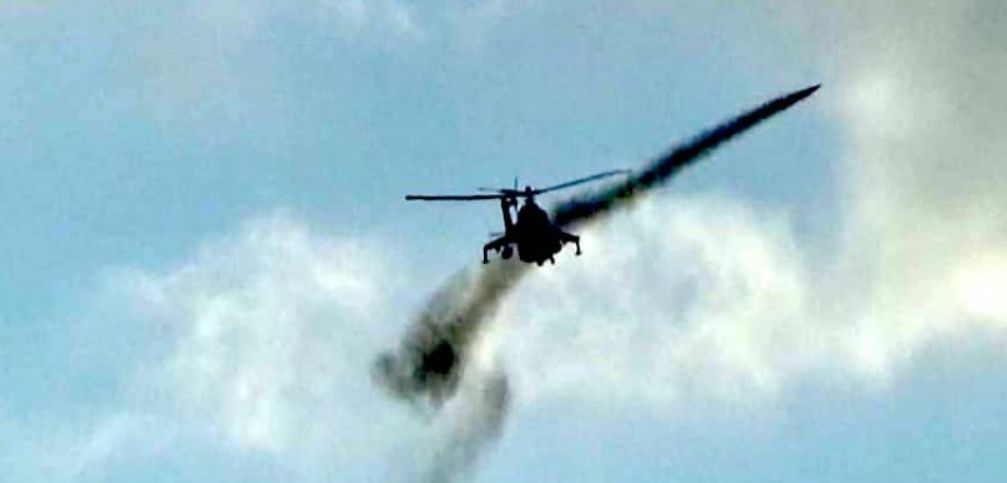
As was reported
recently that there is fierce fighting in Demoso,
Loikaw, and Hpruso townships. The regime has carried
out airstrikes on civilian resistance fighters and used artillery on civilian
areas. It has also brought
hundreds of reinforcements into Kayah State.
About 10 junta
soldiers were reportedly killed and 10 wounded during a shootout with civilian
resistance fighters in Kani Township, Sagaing Region,
on Wednesday afternoon. The Kani’s People Defense Force ambushed five military vehicles
carrying around 70 troops on the Monywa-Kalewa
highway, according to residents.

When (posted
on 5 April 2021) we asked does
Myanmar now face civil war, it looks now that Myanmar is at a point of
no return. The army’s February coup, meant to shift power within the existing
constitutional framework surgically, has instead unleashed revolutionary energy
that will be nearly impossible to contain.
Over the past four
months, protests and strikes have continued despite the reported
killing of more than 800 people and the arrest of nearly 5,000 more. On April
1, elected members of parliament from Aung San Suu Kyi’s National League for
Democracy (NLD), together with leaders from other political parties and
organizations, declared a “national
unity government” to challenge the authority of the recently established
military junta. And through April and May, as fighting flared between the
junta and ethnic minority armies, a new generation of pro-democracy fighters
attacked military positions and administrative offices across the country.
However, the Rakhine
communities say that Myanmar’s National Unity Government’s (NUG)
policy on Rohingya does not represent the Rakhine people.
The NUG, formed by
elected lawmakers in mid-April to rival the military regime, on June 3 said it
would replace the 1982 Citizenship Law with legislation offering the Muslim
community citizenship and scrap the National Verification Cards that identify
the Rohingya as foreigners. The Muslims in Rakhine State identify as
Rohingya but are labeled ‘Bengali’ by many to imply they are illegal immigrants
from neighboring Bangladesh. They are denied citizenship and freedom of
movement by the authorities.
The All Arakanese
Solidarity Committee (AASC), a Rakhine State-based network of civil society
organizations, community leaders and politicians, and the Arakan Liberation
Party (ALP), has released statements in opposition NUG’s Rohingya policy.
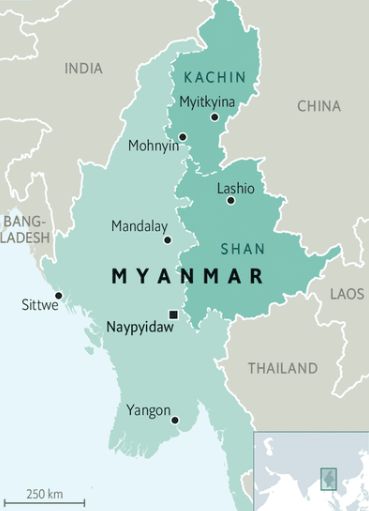
The junta could
partially consolidate its rule over the coming year, but that would not lead to
stability. Myanmar’s pressing economic and social challenges are too complex,
and the depth of animosity toward the military too great for an isolated and
anachronistic institution to manage. At the same time, the revolutionaries will
not be able to deal a knockout blow anytime soon.
As the stalemate
continues, the economy will crumble, extreme poverty will skyrocket, the
healthcare system will collapse, and armed violence will intensify, sending
waves of refugees into neighboring China, India, and Thailand. Myanmar will
become a failed state, and new forces will appear to take advantage of that
failure: to grow the country’s multi-billion-dollar-a-year methamphetamine
business, to cut down the forests that are home to some of the world’s most
precious zones of biodiversity, and to expand wildlife-trafficking networks,
including the very ones possibly responsible for the start of the COVID-19
pandemic in neighboring China. The pandemic itself will fester unabated.
The task now is to
shorten this period of state failure, protect the poorest and most vulnerable,
and begin building a new state and a freer, fairer, and more prosperous
society. A future peaceful Myanmar can only be based on both an entirely
different conception of its national identity, free of the ethnonationalist narratives of the past, and a transformed
political economy. The weight of history makes this the only acceptable outcome
but also a herculean task to achieve. The alternative, however, is not a
dictatorship, which can no longer achieve stability but rather an
ever-deepening state failure and the prospect of a violent, anarchic Myanmar at
the heart of Asia for decades to come.
Myanmar is a colonial creation
Myanmar is a colonial
creation. Over the course of the nineteenth and early twentieth centuries, the
United Kingdom conquered the coastline from Bengal to
the Malay Peninsula, the valley of the Irrawaddy
River, and then the surrounding uplands. Myanmar, then called Burma, was
forged through military occupation and governed as a racial hierarchy that is
partly carried over to the present.
Modern Burmese
politics emerged a century ago, and at its core was an ethnonationalism rooted
in the notion of a Burmese-speaking Buddhist
racial identity. After winning independence in 1948, the new Burmese state
tried to incorporate those non-Burmese peoples of the country also deemed
indigenous, such as the Karens and the Shans, but
within a Burmese racial and cultural supremacy
framework. Those peoples categorized as “aliens,” such as the more than
700,000 people from the Rohingya Muslim community
viciously expelled to Bangladesh in 2016 and 2017, have fared worse.
Myanmar’s nation-building project has failed for decades, leaving behind a
landscape of endemic armed conflict and a country that has never truly been
whole.
For example as
tensions peaked between Karen and Bamar in early 1949, Burmese
irregular forces committed a series of mass killings on the outskirts of
the then-capital that have never been officially acknowledged.
The Burmese army has
been the self-appointed guardian of this ethnonationalism. It is the only army
in the world that has been fighting nonstop
since World War II: against the British and then the Japanese, and, after
independence, against an extraordinary array of opponents, including
Washington-backed Chinese nationalist armies in the 1950s, Beijing-backed
communist forces in the 1960s, drug lords, and ethnic armed forces struggling
for self-determination, all the while taking as well as inflicting enormous
casualties. Since the 1970s, most of the fighting has been confined to the
uplands, where the army became an occupation force imposing a central rule on
ethnic minority populations. But now and then, the army would descend into the
cities of the Irrawaddy River valley to crush dissent. The ranks of the armed
forces have grown to over 300,000 personnel. In recent years, the military has acquired
new Chinese and Russian combat aircraft, drones, and rocket artillery. It
is led by an officer corps that cannot imagine a Myanmar where the military is
not ultimately in control.
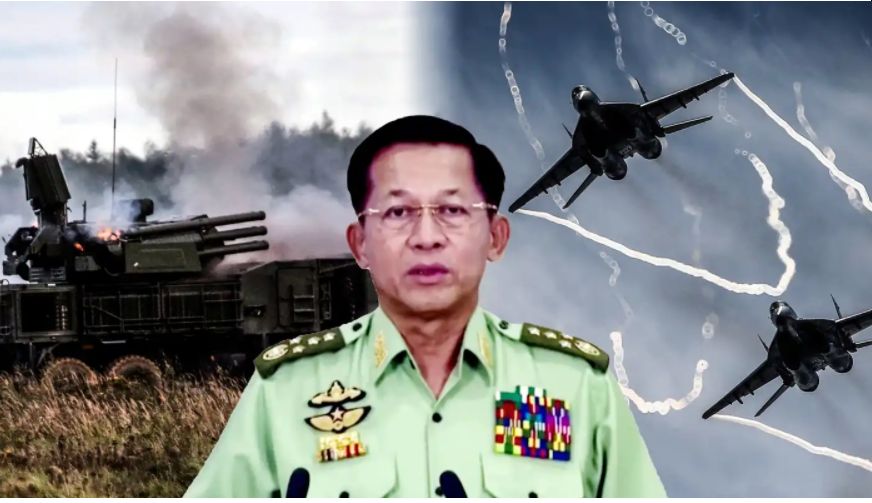
For four decades
after independence, successive civilian and military governments embraced
socialism in response to colonial-era economic inequalities. The main
opposition to ruling governments was communists. During the 1960s, the military
junta combined the nationalization of major businesses with extreme isolation
from the rest of the world. But that orientation shifted in 1988, when a new
army junta seized power, rejected socialism, and began encouraging private
business, foreign trade, and foreign investment. Over the following years,
however, Western countries began to impose sanctions in solidarity with a
nascent democracy movement. At the same time, the army’s principal battlefield
enemy, the Beijing-backed communist insurgency in the northeast, collapsed,
making a trade with China possible for the first time in decades. The net
result was Burmese capitalism intimately tied to China’s giant industrial
revolution next door.
Illicit narcotics syndicates
The political economy
that emerged during the 1990s and early years of this century were the most
unequal since colonial times. Illicit narcotics syndicates
flourished, especially in areas where the junta had reached cease-fires
with local militias. Timber and mining (especially of jade) enriched a cohort
of generals, militia leaders, and business partners, who invested these profits
in real estate in the country’s biggest city, Yangon, sending housing prices
millions of dollars. By 2008, newly discovered offshore gas fields provided the
junta with over $3 billion a year, money that those with the right
connections could access at ludicrously low exchange rates. Not all army
officers accumulated much wealth, but all enjoyed access to patronage networks
to transform power into wealth.
No one paid taxes,
and the state provided next to no social services, with the World Health
Organization listing Myanmar’s health system at the absolute bottom of its
table of national health systems in 2000. The army confiscated land on an
enormous scale from ordinary people. Then, in 2008, a cyclone killed
140,000 people. Landlessness, the cyclone, and other environmental threats
relating to climate change fueled an epic migration from west to east, from
lowland ethnic Burmese areas to Yangon and upland minority areas, and from
everywhere around the country to Thailand, where three million to four million
unskilled laborers from Myanmar work today. Myanmar’s ethnic demographics
became further jumbled, separating identity from a place.
Ethnonationalism had
no ideological rivals. In 1989, the generals changed the name of Burma, a
geographic term used by Europeans since the sixteenth century to mean the area
around the Irrawaddy valley, to Myanmar, an ethnonym for the Burmese-speaking
majority. Socialism and communism had been discredited. In their place came a
nationalist narrative rooted in a country's conception as a union of indigenous
“national races,” with the Burmese-speaking Buddhist people, the Myanmar
people, and their culture at the unquestioned center.
A decade ago, reforms
came about not because of sanctions or diplomatic engagement but because the
country’s aging autocrat, General Than Shwe, believed that a new constitutional
setup would help ensure him a safe and comfortable retirement. He didn’t want
to hand power to a new military dictator, who might one day turn against him,
and he believed the more prudent option was to split power between an army
under a younger cohort of generals and a government led by the pro-army party
he had created, the Union Solidarity and Development Party. But in 2011, the
reformist ex-generals leading the USDP went off script,
releasing political prisoners, including Aung San Suu Kyi, ending media
censorship, freeing the Internet, and ushering in a level of political freedom
unknown for half a century. Western governments, hoping democracy might be just
around the corner, rolled back sanctions, and the country’s economy
boomed. The opening of the telecommunications sector sparked a revolution in
connectivity: in 2011, almost no one in Myanmar had a phone; by 2016, most
people had smartphones and were on Facebook.
The army, however,
was left in its own universe. When Than Shwe retired, he promoted a relatively
junior officer, Min Aung Hlaing, to be the new commander in chief, with the
explicit task of safeguarding the army’s preeminence. But Min Aung Hlaing and
the new crop of generals below him were decades younger than the men of the old
junta, and they had little access to the moneymaking networks of prior decades.
At the same time, the reforms begun in 2011 shrank the army’s role in the
economy considerably. It lost its privileged access to foreign currency and
corporate monopolies. Its share of the national budget was reduced. Moreover,
the army no longer had a say in economic policy. Some of its former business
partners lost out to newly arrived foreign competition; others thrived in the
open environment. But few companies were any longer dependent on the military’s
largess.
The generals wanted to upgrade their weaponry
In the 2010s, the
army placed less emphasis on moneymaking and more on the exercise of violence.
The generals wanted to upgrade their weaponry and become, in their own words, a
“standard modern army.” They dreamed of ending the country’s endless internal
armed conflicts on their own terms, using a mix of pressure and persuasion to
disarm and demobilize the many and varied forces fighting on behalf of ethnic
minority communities. Over the past ten years, their focus has been campaigning
against new ethnic minority forces, particularly the Arakan, Kokang, and Ta’ang armies, all linked to China and the ethnic cleansing
of the Rohingya. To some extent, their uncompromising stance found support
among the public, as Burmese ethnonationalism flourished on social media and
among Buddhist organizations that saw Islam and all things foreign as threats
to the conservative order they espoused.
From 2011 to 2015,
the army shared power with the reformist ex-generals of the USDP in what was
more or less an amicable relationship. But in 2016, after Aung San Suu Kyi’s
NLD won a landslide election victory, they found themselves in government with
their longtime political foes. Under the constitution, the army held three
ministries, Defense, Home Affairs (which controlled the police), and Border
Affairs, and a quarter of the seats in parliament. But Aung San Suu Kyi enjoyed
real power. Her supermajority meant she could pass any law she wished and
control the country’s budget and the entire range of government policy apart
from the security issues directly under the military’s purview.
Aung San Suu Kyi’ and the generals shared
conservative values
She and the generals
shared conservative values, including respect for age, self-discipline, and the
Buddhist establishment, and had a similar ethnonationalism worldview. They were
united in believing that the Western reaction to the Rohingya expulsions was
unfair. In 2019, Aung San Suu Kyi acted out of conviction, not expediency, when
she went to The Hague to defend the army before the International Court of
Justice. But her relationship with the generals was testy at best. The NLD
feared a coup. The army feared a conspiracy between Aung San Suu Kyi and the
West to remove it from the government altogether. Min Aung Hlaing worried that
Aung San Suu Kyi might one day throw him under the bus to placate her erstwhile
international supporters, many of whom had disavowed
her after the violent displacement of the Rohingya.
The tipping point
As political tensions
grew, the country’s economy reached a tipping point. In 2016, the central bank,
following advice from the International Monetary Fund, introduced new
prudential regulations for Myanmar’s private banks at a time when as many as
half of all loans in the country were nonperforming, and the once white-hot
real estate market had just nose-dived. Aung San Suu Kyi suddenly found that
she had leverage over a business class that many of her supporters loathed. The
cronies who had become rich under the old junta now vied for her attention. Her
technocrats pushed for further liberalization. At the same time, Beijing, which
had nurtured close ties with Aung San Suu Kyi, proposed multibillion-dollar
infrastructure projects through its Belt and Road Initiative, including the
China-Myanmar Economic Corridor, which would stretch from China’s southwestern
province of Yunnan to the Bay of Bengal.
The COVID-19 pandemic
Then came the
COVID-19 pandemic. Its impact on public health was minimal, but lockdowns and
disruptions to foreign trade sent the economy into a tailspin. The government’s
response was anemic at best, offering virtually no cash support to those
hardest hit. According to one survey conducted in October 2020, the proportion
of the population living in poverty (those making less than $1.90 a day) had
risen from 16 percent to 63 percent over the previous eight months, with a
third of people polled reporting no income since August 2020. However, public
trust in Aung San Suu Kyi only grew as she appeared on Facebook for the first
time, live-streaming conversations with healthcare workers and others. Millions
didn’t blame her for the economy’s ills and instead felt that they finally had
a leader looking out for them.
But alarm bells were
already ringing, especially outside the Burmese-majority heartland. After the
ethnic cleansing of the Rohingya Muslims, an entirely new dynamic emerged in
Rakhine State, in the west of the country: the rise of the Arakan Army, set on
achieving self-determination for the state’s Rakhine-speaking Buddhist
community. In 2018, the Arakan Army began large-scale attacks on government
positions. It was the most significant armed insurrection in Myanmar in a
generation. By late 2020, it had pinned down several army divisions and had
gained de facto authority over vast swaths of the Rakhine countryside.
At the other end of
the country, the methamphetamine industry, which supplied markets as far afield
as Japan and New Zealand, was thriving as never before. The drugs were produced
in areas controlled by militias near the Chinese border, with the bulk of profits
going not to anyone in Myanmar but too powerful transnational syndicates, such
as the one headed by the Chinese Canadian Tse Chi Lop, who was arrested in
January in Amsterdam and is purported to have made as much as $17
billion in revenue annually. Drugs encouraged a growing ecosystem of money
laundering and other illicit industries, with over a hundred casinos in the
northeast, near the Chinese province of Yunnan, and plans for a giant gambling
and cryptocurrency hub on the border with Thailand.
National elections
took place last November in the feverish context of rising conflict and
economic woes. But people still voted overwhelmingly for Aung San Suu Kyi. The
army leadership was shocked, having believed that the NLD would fare poorly,
given the state of the economy, and that the military top brass would have at
least a say in choosing the next president. Instead, Aung San Suu Kyi, thanks
to the scale of her win, seemed set to be more powerful still. Efforts by Aung
San Suu Kyi and Min Aung Hlaing to reach an understanding went nowhere. He
fixated on allegations of electoral fraud and demanded an investigation into
the election. She refused to consider this. The army felt humiliated. But
ordinary people, thrilled by her victory, could only imagine better times
ahead.
The army seized power
On February 1, the
army seized power, arresting Aung San Suu Kyi and other NLD leaders. It was billed
not as a coup d’état but as a state of emergency under the constitution. The
new junta is composed of several political parties (other than the NLD) and top
generals. Min Aung Hlaing stacked his cabinet with senior technocrats and, in
his first public appearances, promised to prioritize the post-pandemic economic
recovery and even suggested a multibillion-dollar stimulus package. He seems to
have thought that he could take over without much of a fuss, sideline the NLD,
focus on fixing the economy, and then hold fresh elections skewed to his
advantage. If so, he completely misread the public mood.
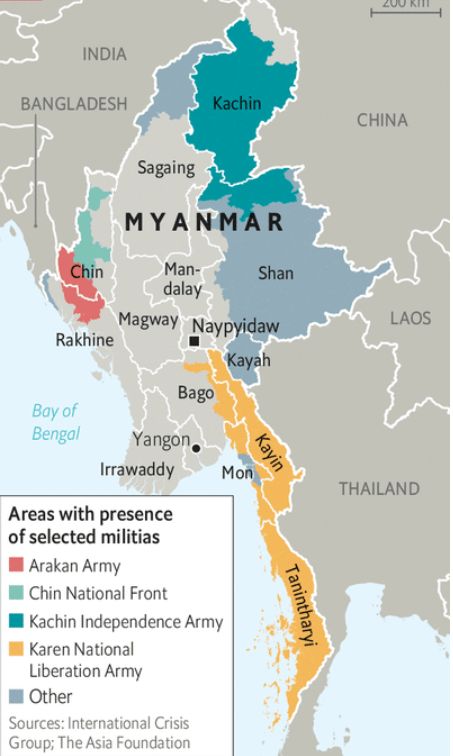
The reaction to the
coup was spontaneous and visceral. Within days, hundreds of thousands of people
poured onto the streets demanding an end to military rule, the release of Aung
San Suu Kyi and other civilian leaders, and the restoration of the elected government.
At the same time, a civil disobedience movement began, with medics leaving
government hospitals and quickly spread across the public sector, from
ministerial departments down to local administrative bodies. On February 22, a
general strike shut down businesses, including banks, all around the country.
And a campaign on Facebook meted out “social punishment” in the form of
orchestrated public attacks on any person or business thought to have links to
the army or the junta.
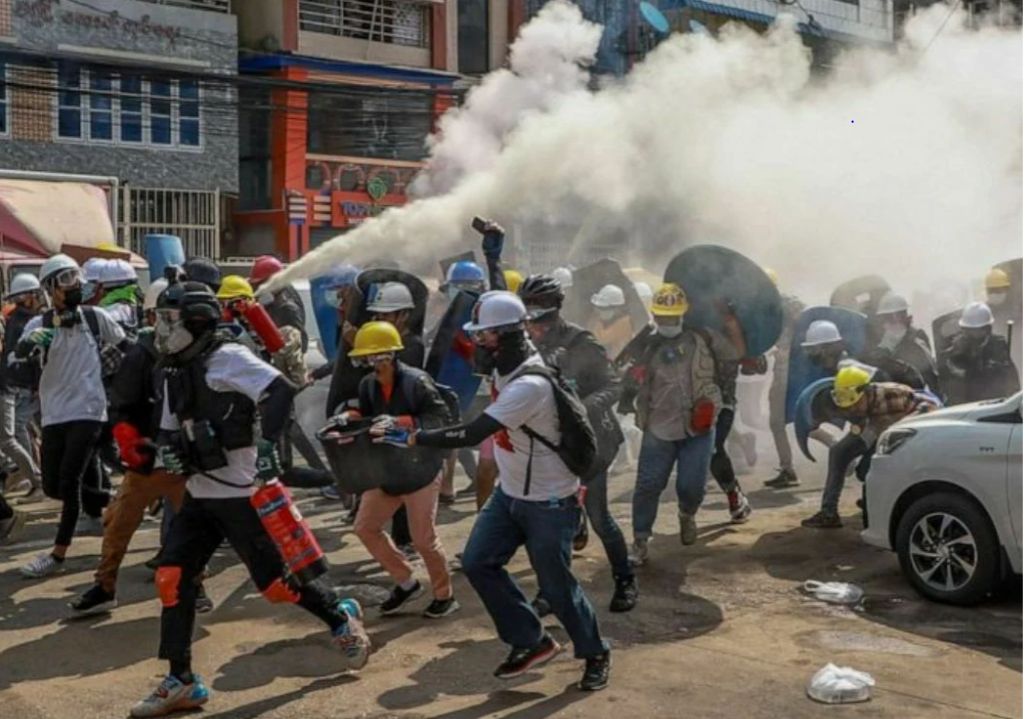
The army cracked down
mercilessly. It had held back at first, perhaps in the hope that the protests
would melt away on their own. But over the last week of February,
battle-hardened troops of the army’s elite light infantry divisions, including
the units responsible for the ethnic cleansing of the Rohingya, began moving
into Yangon and other cities. A campaign of terror accompanied the lethal use
of force: as night fell, the Internet went dark, and soldiers began firing
indiscriminately in residential neighborhoods, setting off sound grenades,
breaking down doors, and hauling people away. The large crowds dissipated, but
smaller and even more determined protests persisted. Young men and women
erected makeshift barricades and wielded shields and occasionally improvised
weapons to defend themselves against the soldiers’ automatic fire. On March 14
alone, dozens were killed in Yangon’s industrial suburb of Hlaingthaya.
On March 27, over a hundred died as the army opened fire on crowds across
Myanmar.
The carnage
radicalized the resistance. With videos of the beating and killing of civilians
shared over the Internet, the popular desire to reverse the coup transformed
into a determination in some quarters to see an end to the army altogether.
Protesters raised signs calling for “R2P,” referring to the principle of “the
responsibility to protect,” which obliges the international community to
intervene in a country to defend its people from crimes against humanity, even
if such action violates that country’s national sovereignty. For a while, many
in Myanmar genuinely expected that the world would save them from a new
dictatorship. But by late March, with no armed international intervention in
sight, many young protesters turned to armed insurrection. In Kalay, near
India, residents resolved to fight back as the “Kalay Civil Army,” arming
themselves with homemade hunting rifles, killing several soldiers, and
holding out for ten days before the army overran their positions. Dozens of new
groups, locally organized and lightly armed, began appearing in different parts
of the country over the following months. In May, another militia called the Chinland Defense Force held the town of Mindat,
in the rugged western uplands, for three weeks before the army, using artillery
and helicopter gunships, forced them to withdraw. All the while, hundreds of
young men and women made their way to territories controlled by ethnic minority
armies to receive training, including in explosives. By late May, there had
been dozens of arson and other attacks on police and administrative offices and
nearly a hundred small bombings against junta-linked targets, including in
Yangon.
These new guerilla
movements can certainly keep the junta off balance. But the insurrectionists
will not build a new army to challenge the existing one without significant
help from a neighboring country, which seems next to impossible. And nothing in
the history of Myanmar’s army suggests that a sizable chunk of its forces
would break away and join a rebellion. That leaves the ethnic minority armies
as the only other possible agents of a broader uprising. The Kachin Independence Army and the Karen National Liberation Army have already mounted
new army positions in the far north and southeast of the country. Other groups,
too, may move from statements of political support to armed action. But even
the combined might of the ethnic armed organizations, numbering perhaps 75,000
fighters in total, would be no match for military with far superior artillery
and a monopoly on airpower. Moreover, the most powerful ethnic armed
organization, the United
Wa State Army, with 30,000 troops, has deep links
to China, having emerged from the old communist insurgency. It will heed the
advice of Beijing, which has no love for the Myanmar army but does not want to
see an all-out civil war.
The United Wa State Army (UWSA) is a non-state armed group that
administers an autonomous zone in the difficult-to-reach Wa
Hills of eastern Myanmar. As China expands its geopolitical interests across
Asia through the Belt and Road Initiative, the Wa has
come to play a pivotal role in Beijing's efforts to extend its influence in
Myanmar:
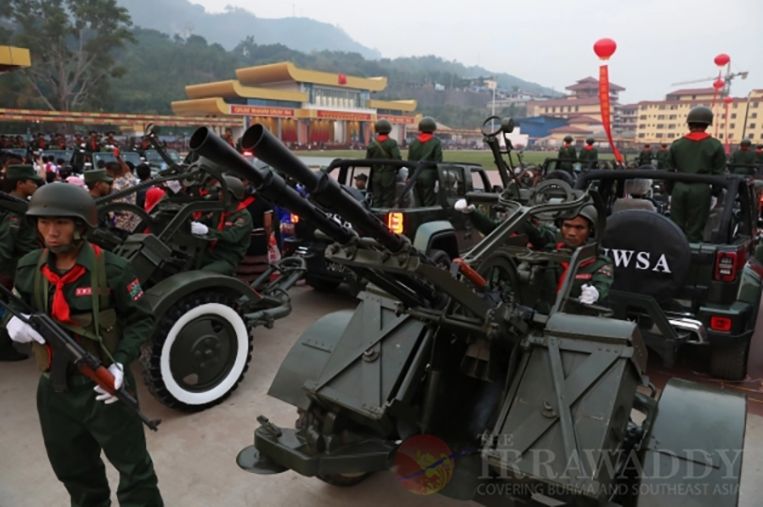
More than anything
that happens on the battlefield, it is the ongoing implosion of the economy
that will turn Myanmar into a failed state. Industries on which ordinary
households rely, such as tourism, have collapsed, as have other sources of
income, such as remittances from overseas, which totaled as much as $2.4
billion in 2019, a result of income lost by migrant workers abroad during
the global pandemic. The garment industry employed over a million people, many
young women, and was a success story during the past decade. Still, it has been
devastated as orders from Europe have dried up. The future of the agricultural
sector, the biggest employer in the country, remains uncertain, with logistics
disrupted by strikes and China now closing border crossings out of fear of
COVID-19. The most critical is that the financial sector has been paralyzed by
a mix of strikes, the unwillingness or inability of the central bank to provide
added liquidity, and a general collapse in confidence. Closed banks mean no cash
at ATMs and thousands of businesses unable to make payroll, taking trillions of
kyats (equal to billions of dollars) each month out of circulation. The
knock-on effect across all sectors has been catastrophic.
As for the current
state of Covid, Local media reports Myanmar military gov has been preparing a
quarantine center in Yangon as the COVID-19 outbreak hits the country, see
picture. The regime forcibly shut down Q centers with full medical facilities
by the civilian gov right after the coup.
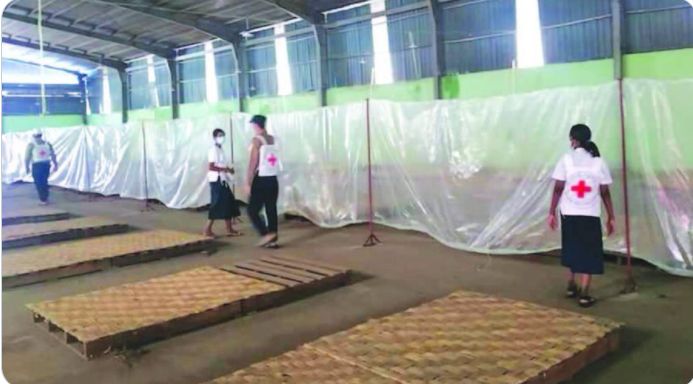
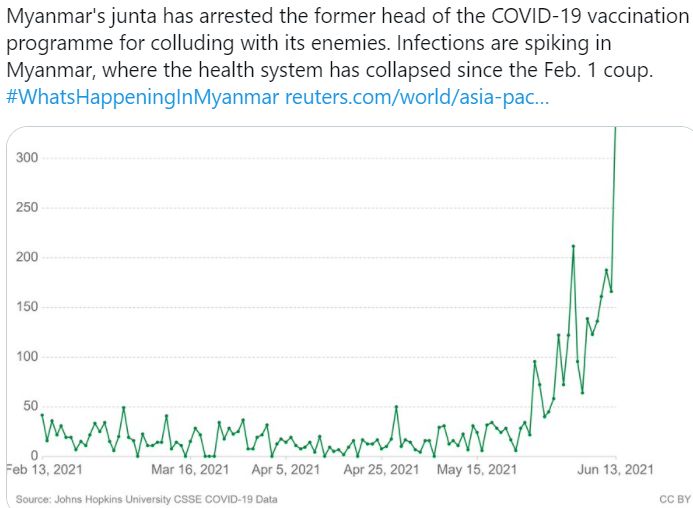
The economy may be on
its knees, but the junta will likely not suffer. Revenues from natural gas and
mining will continue to flow into its coffers. The army-owned conglomerates
provide at most a fraction of the $2.5 billion, or so the military receives annually
from the regular budget. So foreign sanctions on those firms won’t have much
effect. In any case, the junta now controls the country’s entire $25
billion budget: the first cuts won’t be to defense in any fiscal squeeze.
But the people of
Myanmar will suffer enormously. The UN Development Program expects half of
Myanmar’s population of 55 million to fall into poverty over the coming six
months. The World Food Program worries that 3.5 million more people will face
hunger. Lifesaving medicines and treatments are in extremely short supply. Over
the course of 2021, 950,000 infants will not receive the vaccines that they
would normally get for diseases such as tuberculosis and polio. Those who
suffer most will include those who have always been the most vulnerable,
including landless villagers, upland farmers, migrant workers, the Rohingya,
people of South Asian descent, and the internally displaced. The economy will
collapse not with a bang but with a whimper as a new generation grows up
severely malnourished and uneducated.
Myanmar as a failed
state may look something like this: The army holds the cities and the Irrawaddy
valley, but urban guerilla attacks and a spreading insurrection prevent any
firm consolidation of junta rule. The strike's end, but millions remain unemployed,
and the vast majority of people have little or no access to basic services.
Some ethnic armed groups can carve out additional territory, while others come
under withering air and land assault. In Rakhine State, the Arakan Army expands
its de facto administration, and in the eastern uplands, old and new militia
groups strengthen their ties to transnational organized crime networks.
Extractive and illicit industries become a bigger piece of Myanmar’s economic
pie. As armed fighting intensifies, Beijing, fearing instability above all,
feels compelled to increase its sway over all territories east of the Salween
River. Myanmar becomes a center for the spread of disease, criminality, and
environmental destruction, with human rights atrocities continuing unchecked.
Successful change must come from within
Myanmar’s future need
not be totally bleak, however. Successful change must come from within, and
there is absolutely no doubt, given what has happened since February, that
Myanmar’s young people are determined to alter the course of their country’s
history. It is they who must chart a path forward. But global action now could
alleviate some of the sufferings in the country and help it more swiftly escape
impending disaster.
First, the
international community needs to agree to a resolution in the UN Security
Council that clearly demands a quick and peaceful transition back to an elected
civilian government. China must be on board; there is simply no substitute for
China’s involvement because of its economic clout in Myanmar and its deep ties
to many of its ethnic armed organizations. International sanctions that do not
involve China may be symbolically important, but they will be just that:
symbolic. The junta can survive with just China’s tacit support. But Beijing
can play a constructive role. It has always had difficult relations with the
generals, is wary of instability, would prefer a return to civilian government,
and remains uncertain of its next moves. Diplomacy between Beijing and
Washington will be essential in achieving a Security Council resolution and
thereby providing the needed framework for international cooperation on
Myanmar. Several countries in the region are important, especially India and
Thailand, Myanmar’s other key neighbors, and Japan, whose aid and investments
have been a big part of the country’s economic growth over the past decade. The
Association of Southeast Asian Nations, the regional body, is far less
significant; it initiated dialogue with the junta in April that has yet to bear
fruit.
Second, outside
powers must support and encourage all those working not only for democracy in
Myanmar but also for the broad transformation of Myanmar politics and society.
That includes serious efforts, possibly through an expanded UN civilian
presence in Myanmar, to monitor human rights abuses and negotiate the release
of political prisoners. However, it is critical not to raise false hopes by
offering people in Myanmar the chimera of international salvation; that would
only steer energy away from building the necessary and broadest possible
coalitions at home.
Third, outside help
needs to be based on an appreciation of Myanmar’s unique history, one in which
past army regimes have withstood the strictest international isolation and the
unique psychology of the generals themselves, molded by decades of unrelenting
violence. The international community’s usual carrots and sticks won’t work.
Fourth, foreign
governments should assist poor and vulnerable populations as much as possible,
perhaps focusing initially on providing COVID-19 vaccinations. But such
assistance must be handled with tremendous political skill and designed in
collaboration with healthcare workers themselves, not inadvertently to entrench
the junta's grip. Many of the junta’s opponents have wanted to crash the
economy to help trigger revolution. Still, as weeks stretch into months and
years, it will be necessary to protect the civilian economy as much as
possible, to prevent a worsening humanitarian disaster. Responsible global
firms that do not do business with the army should be encouraged to stay in the
country. A healthy and well-fed population will be better able to push for
political change.
Governments must try
different initiatives with as much flexibility and international coordination
as possible. There is no magic bullet, no single set of policies that will
solve the crisis in Myanmar. That’s because the crisis isn’t just the result of
the February coup; it is the outcome of decades of failed state-building and
nation-building and an economy and a society that has been so unjust for so
long to so many. The outside world has long tended to see Myanmar as a fairy
tale, shorn of its complexities, in which an agreeable ending is just around
the corner. The fairy tale must now end and be replaced with serious diplomacy
and well-informed, practical strategies.
Conclusion
The Tatmadaw is far
from being defeated. Even if its opponents band together, as the shadow
government hopes, its 350,000-odd soldiers would still dwarf the rebels’
combined forces of around 80,000. Over the past decade, it has built up an
arsenal of sophisticated weaponry, enabling it to mount combined land and air
offensives. A resolution passed on June 18th by the UN General Assembly,
calling for an end to arms sales to Myanmar and an end to violence and the
release of detainees will make little difference. The Tatmadaw’s two
biggest suppliers, China and Russia, abstained.
There have been hundreds
of defections from the army since the coup, but it is doubtful that enough
would abandon the force to influence the conflict’s outcome. Plus, their
fortunes may change with the weather. Hostilities with ethnic rebels, who live
in the country’s uplands, are usually suspended when the monsoon arrives. If
that annual pattern holds this year, the Tatmadaw may redeploy troops to the
heartland.
The shadow
administration, known as the National Unity Government (NUG), is trying to knit
the disparate anti-regime forces into a standing army. But different ethnic
rebels are wary of one another, past efforts at co-operation have failed, and
of the NUG, which a Bamar political party formed criticized before the coup for
ignoring the grievances of ethnic minorities. Even the Chin National Front, the
only ethnic militia formally allied with the NUG is worried that Bamars will dominate their coalition, says Salai Lian Hmung
Sakhong, the front’s vice-chairman and the NUG’s
minister of federal affairs. Some rebel groups have no interest in taking on
the Tatmadaw. They include the biggest, the United Wa
State Army, with 30,000 troops. Others, such as the Arakan Army, which had
engaged the Tatmadaw in fierce fighting until last November, saw an opportunity
to extract concessions from the army while under pressure.
But the fragmented
nature of the resistance also makes it more difficult for the Tatmadaw to root
out insurgents. The Tatmadaw’s brutality has turned the entire country against
it. For the first time since some students took up arms after the bloody suppression
of an uprising in 1988, Bamars joined ethnic rebels
in their war against the army.
For updates click homepage here